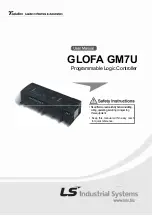
I2C Module Registers
1029
SPRUH22I – April 2012 – Revised November 2019
Copyright © 2012–2019, Texas Instruments Incorporated
C28 Inter-Integrated Circuit Module
Table 14-11. I2C Interrupt Source Register (I2CISRC) Field Descriptions (continued)
Bit
Field
Value
Description
2-0
INTCODE
Interrupt code bits. The binary code in INTCODE indicates the event that generated an I2C
interrupt.
000
None
001
Arbitration lost
010
No-acknowledgment condition detected
011
Registers ready to be accessed
100
Receive data ready
101
Transmit data ready
110
Stop condition detected
111
Addressed as slave
A CPU read will clear this field. If another lower priority interrupt is pending and enabled, the value
corresponding to that interrupt will then be loaded. Otherwise, the value will stay cleared.
In the case of an arbitration lost, a no-acknowledgment condition detected, or a stop condition
detected, a CPU read will also clear the associated interrupt flag bit in the I2CSTR register.
Emulator reads will not affect the state of this field or of the status bits in the I2CSTR register.
14.5.6 I2C Prescaler Register (I2CPSC)
The I2C prescaler register (I2CPSC) is a 16-bit register (see
) used for dividing down the I2C
input clock to obtain the desired module clock for the operation of the I2C module. See the device-specific
data manual for the supported range of values for the module clock frequency.
lists the bit
descriptions. For more details about the module clock, see
IPSC must be initialized while the I2C module is in reset (IRS = 0 in I2CMDR). The prescaled frequency
takes effect only when IRS is changed to 1. Changing the IPSC value while IRS = 1 has no effect.
Figure 14-21. I2C Prescaler Register (I2CPSC)
15
8
7
0
Reserved
IPSC
R-0
R/W-0
LEGEND: R/W = Read/Write; R = Read only; -
n
= value after reset
Table 14-12. I2C Prescaler Register (I2CPSC) Field Descriptions
Bit
Field
Value
Description
15-8
Reserved
These reserved bit locations are always read as zeros. A value written to this field has no effect.
7-0
IPSC
I2C prescaler divide-down value.
IPSC determines how much the CPU clock is divided to create the module clock of the I2C module:
module clock frequency = I2C input clock frequency/(IPSC + 1)
Note: IPSC must be initialized while the I2C module is in reset (IRS = 0 in I2CMDR).
NOTE:
To meet all of the I2C protocol timing specifications, the module clock must be configured
between 7-12 MHz.
14.5.7 I2C Clock Divider Registers (I2CCLKL and I2CCLKH)
As explained in
, when the I2C module is a master, the module clock is divided down for
use as the master clock on the SCL pin. As shown in
, the shape of the master clock
depends on two divide-down values:
•
ICCL in I2CCLKL (summarized by
and
). For each master clock cycle, ICCL
determines the amount of time the signal is low.
•
ICCH in I2CCLKH (summarized by
and
). For each master clock cycle, ICCH
















































